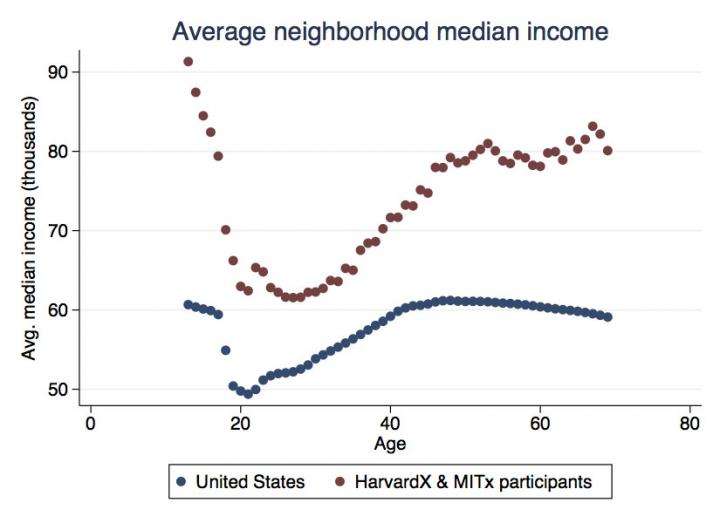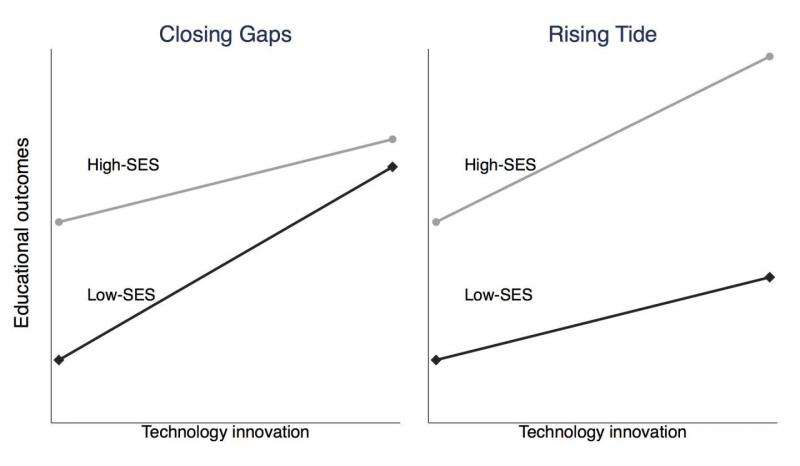December 4, 2015 report
Study shows Massive Open Online Courses used mostly by wealthier people

(Phys.org)—A pair of researchers looking into whether Massive Open Online Courses (MOOCs) are helping to bridge the disparity gap in education access in the U.S. has found that those who take the courses tend to be from wealthier neighborhoods. In their paper published in the journal Science, John Hansen, with Harvard University and Justin Reich, with MIT describe their research efforts and why they came to believe that MOOCs are not the remedy to educational disparity that many had hoped.
Access to a high quality education is not guaranteed in the U.S. People who live in poorer neighborhoods tend to live in less well funded schools with lower success rates. Over the years some have espoused technological advances as the key to leveling the playing field—some believed radio could change things by offering educational programming, others believed television would help, offering even more programming such as that provided by PBS. Unfortunately, such hopes have not been realized as the disparity gap in education has only grown wider between people living in rich neighborhoods versus those living in poor neighborhoods. More recently, some have suggested that the Internet might finally provide the path to change—universities such as Harvard and MIT began offering free courses online, which over time have come to be known as MOOCs. But now, Hansen and Reich have found that the majority of young people taking advantage of such coursework are kids living in wealthy neighborhoods, suggesting that instead of shrinking the disparity gap, they are actually making it wider.
To come to these conclusions, the research pair obtained data on 68 students enrolled in MOOCs offered by Harvard and MIT covering the years 2012 to 2014, which included student addresses. Those addresses when compared with census data allowed the researchers to identify the average wealth and education level of adults in the neighborhoods where the students lived. The researchers looked at both registration and completion rates of the student enrollees, and found that the people using MOOCs to further their education were primarily from wealthier neighborhoods, thus it was no surprise that most of those that completed the courses and received a certificate, were also from those same wealthy neighborhoods.

The study suggests that there are obstacles that prevent students from less wealthy neighborhoods from accessing free online education and presumably the better economic opportunities that would follow were those obstacles to be removed.
More information: J. D. Hansen et al. Democratizing education? Examining access and usage patterns in massive open online courses, Science (2015). DOI: 10.1126/science.aab3782
Abstract
Massive open online courses (MOOCs) are often characterized as remedies to educational disparities related to social class. Using data from 68 MOOCs offered by Harvard and MIT between 2012 and 2014, we found that course participants from the United States tended to live in more-affluent and better-educated neighborhoods than the average U.S. resident. Among those who did register for courses, students with greater socioeconomic resources were more likely to earn a certificate. Furthermore, these differences in MOOC access and completion were larger for adolescents and young adults, the traditional ages where people find on-ramps into science, technology, engineering, and mathematics (STEM) coursework and careers. Our findings raise concerns that MOOCs and similar approaches to online learning can exacerbate rather than reduce disparities in educational outcomes related to socioeconomic status.
Journal information: Science
© 2015 Phys.org



















